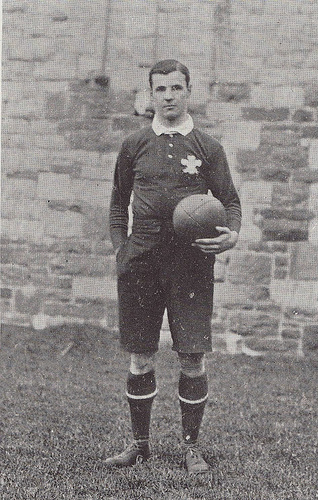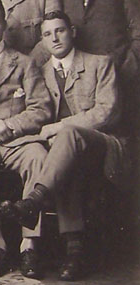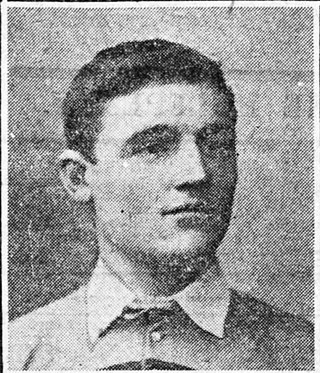
Erith Gwyn Nicholls was a Welsh rugby union player who gained 24 caps for Wales as a centre. Nicholls was known as the "Prince of Threequarters".

Paul Johannes Roos was one of the first South African Springbok rugby union captains and led the first South African rugby team to tour overseas – to Britain in 1906. Roos was born near the South African town of Stellenbosch on 30 October 1880 and completed his education there.

Kenneth Jeffrey Jones OBE was a Welsh sprinter and record breaking Welsh international rugby union footballer. He played for both Wales and the British Isles. He is best known in Wales for his contribution to Welsh rugby, but most notably for his winning try against the All Blacks in 1953.

William Morris Llewellyn was a Welsh international rugby union player. He captained Wales in 1905 and London Welsh in 1902. He was a member of the winning Welsh team who beat the 1905 touring All Blacks in the famous Match of the Century. Llewellyn toured with the British Isles to Australasia in 1904 and won three Triple Crown trophies. He played club rugby for many teams, predominantly for Llwynypia and Newport.

Major Thomas Henry Vile MBE was a Welsh international rugby union player. He played club rugby predominantly for Newport, captaining the side twice and played county rugby for Monmouthshire. He also represented the British Isles in Australia, and after retiring from playing became an international referee. He fought in both World Wars, became a president of the Welsh Rugby Union, was a Justice of the Peace, businessman and High Sheriff of Monmouthshire.
Harold Davies was a Welsh rugby union player who represented Wales and the British Lions. Davies played club rugby for Newport and captained the team in the 1925/26 season.

Phillip Dudley Waller was an English-born international rugby union forward who played club rugby for Newport and Johannesburg. He won six caps for Wales and also played for the British Isles in their 1910 tour of South Africa.

Harry Jarman was a Welsh international forward who played club rugby for Newport and Pontypool. He won four caps for Wales and also played for the British Isles in their 1910 tour of South Africa. In 1928 Jarman died when he threw himself in front of a runaway coal truck which was heading towards a group of playing children.

Harry Packer was an English-born international rugby union prop who played club rugby for Newport and was capped seven times for Wales. Packer had a long association with rugby, as a player, selector, official and in 1924 was the manager of the touring British Isles team.
Rees Thomas was a Welsh international rugby union back row player who was utilised usually as a flanker or Number 8. Thomas played club rugby for Pontypool and county rugby for Monmouthshire. He won eight caps for Wales and played between 1909 and 1913, representing Wales during two Triple Crown winning seasons.

| repyears1 = 1895–1900 | repcaps1 = 9 | reppoints1 = 0 | ru_ntupdate = | coachteams1 = | coachyears1 = | ru_coachupdate = | relatives = Norman Biggs, brother
Cecil Biggs, brother }}
Cardiff Harlequins RFC was a rugby union club located in the Welsh capital city of Cardiff. The team provided several international players during the late 19th century, most notably Gwyn Nicholls, who after leaving the club not only represented Wales but also played for the British Isles on their 1899 tour of Australia. The club disbanded in the 1890s.
Tom Dobson was a Scottish-born rugby union forward who played club rugby for Cardiff and international rugby for Wales. His brother George Dobson was also a rugby player who represented Cardiff and Wales.
William "Pussy" Jones was a rugby union centre who played club rugby for Cardiff and international rugby for Wales.
Denys Douglas Dobson was an English international rugby union forward who played club rugby for Oxford University and Newton Abbot. Dobson played international rugby for England and the British Isles team on its 1904 tour of Australia. Dobson was the first player from a British touring rugby team to be dismissed from the playing field, when he was sent off in a match against the Northern District in Newcastle, New South Wales.

Edwin Thomas Maynard known as Edwin Thomas or "Beddoe" Thomas was a Welsh international rugby union prop who played club rugby for Newport RFC. Thomas was part of the Wales team that won the Triple Crown in 1909, and faced all three major Southern Hemisphere teams; New Zealand, South Africa and Australia, for Newport.
George Ralph Gibson was an English international rugby union forward who played club rugby for Northern. Gibson played international rugby for England and was selected to represent the British Isles on their 1899 tour of Australia. He was described by Matthew Mullineux, the British Isles captain, as a "capital worker".

Paul Robert Clauss was a German-born rugby union three-quarter who played club rugby for Oxford and Birkenhead Park. Clauss was a member of the first official British Isles tour in 1891 and also represented Scotland on six occasions. He was part of two Triple Crown winning teams for Scotland, and made an impressive international start in the 1891 Championship, scoring in all three Scotland games.

Aloysius Mary "Louis" Magee was an Irish rugby union halfback. Magee played club rugby for Bective Rangers and London Irish and played international rugby for Ireland and was part of the British Isles team in their 1896 tour of South Africa.
Joseph Thomas Magee was an Irish rugby union wing. Magee played club rugby for Bective Rangers and played international rugby for Ireland. He is often mistaken as being a member of the British Isles team that toured South Africa in 1896, a position actually taken by his brother James Magee.
 South Africa 1903, 1903, 1903
South Africa 1903, 1903, 1903










